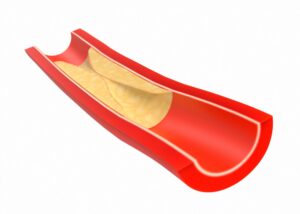The #1 cause for heart attacks and strokes isn’t related to your cholesterol level, instead, it relates to whether you are growing plaque in your arteries.
As we age, arterial plaque continues to grow and thicken; eventually, it becomes harder and harder, much like cement. Newly formed plaque can pop and cause tremendous damage, while the older, more calcified plaques gradually restrict blood flow. Rapid early plaque growth can appear and act like a pimple on your artery wall, and if that plaque lesion pops (technically its called plaque rupture), an arterial plaque lesion will release inflammatory compounds into the artery, and cause a massive clot to form, which blocks blood flow in the artery, and triggers a heart attack, stroke, or death.
So, how do we gauge plaque growth? It is simple, safe, and easy using high-tech ultrasound equipment similar to what monitors the growth of a fetus in the womb. We use this new carotid intimal-media thickness testing (carotid IMT) to precisely calculate arterial plaque growth and reliably estimate patients’ artery age.
The carotid artery is the large one that carries blood from the heart to the brain. The thickness of the plaque growth within it can be measured without radiation or needle sticks–just a touch of gentle pressure on the neck. Research studies have shown that more than 90 percent of the time, the carotid arteries, the coronary arteries, and even the arteries in your legs all grow plaque at the same rate. Therefore, the thickness of plaque in the carotid artery reflects plaque growth everywhere in the body, including the arteries that feed the heart. Several studies have also shown that carotid IMT is an excellent and safe predictor of risk for future cardiovascular events.
How to Measure Carotid Intimal Medial Thickness (Carotid IMT)

The carotid artery is much easier to measure than the arteries in your heart. To receive a carotid IMT test at Forbes Precision Health a patient simply lies comfortably on an exam table. We apply warm ultrasound gel on the neck over the artery. The doctor gently passes a measuring device from the ultrasound machine over the skin and takes pictures of the carotid artery which is just beneath the surface. Dr. Masley or Dr. Forbes will take 12 or more pictures from the right and left with different views and angles. The whole process usually takes 10-12 minutes. At this point, the patient’s job is done. We transfer the images to our computer, enlarge the images, and use a software to measure the artery lining thickness. These measurements are accurate to hundreds of millimeters.
Studies have already calculated average carotid artery plaque thickness in thousands of men and women. So once we’ve calculated our patient’s score, we can use these figures to project the average age of his or her arteries. A 50-year-old man, for instance, might have the plaque of a 40, 50, or 60-year-old ….or more, but never know it.
Over time, we monitor the artery age yearly (checking every year or two) to clarify whether our patient’s plaque is growing, staying the same, or by following Forbes Precision Health’s program long-term—actually shrinking.

The Prevention Group for the American Heart Association considers carotid IMT testing an excellent way to assess future cardiovascular disease risk. They recommend it as a safe and dependable tool. Several studies have confirmed their recommendations, as noted above. If performed regularly over the years, repeated carotid IMT scans can project the age at which one will become high risk for a heart attack or stroke or, most importantly, give us time to recommend the appropriate therapy to prevent and reverse this aging process.
Because of its safety and efficiency when compared to a heart catheterization, IMT testing should be the new gold standard for cardiovascular plaque testing. However, this is not yet the case. Despite its usefulness, 95 percent of doctors are not ordering this screening test for their patients, which is a shame.
For more than 10 years, Forbes Precision Health has used this non-invasive tool to monitor patients’ arterial plaque growth. And, as they follow our program, we’ve seen many whose arterial plaque load has actually shrunk by up to 10 percent a year, with and without the use of cholesterol medications. Dr. Masley has demonstrated this in a recent study in which he investigated 400 subjects who’d had serial carotid IMT exams—once a year—for an average of three years–although some patients were actually tested over a six-year period. Nearly 100 of them (in particular, those who followed our program recommendations) have had a significant decrease in their IMT scores. In fact, many have arteries that are truly ten years younger!
But What if I Have Already Had a Carotid Test?
It is possible that your doctor has ordered an ultrasound study on your carotid arteries. But don’t be misled by the results from typical testing. The standard carotid ultrasound test performed in 95 percent of hospitals and medical clinics around the country does not measure plaque thickness the way a carotid IMT test would. Rather, this Doppler flow study determines whether the blood flow in your arteries is blocked. A seventy percent blockage typically results in a recommendation for carotid artery surgery. Any lower percentage might be called “normal,” even though someone with advanced plaque growth and on the verge of a heart attack or stroke might fall into this category. “Normal” in this case means you are not yet a candidate for surgery, but it says nothing about the age of your arteries, the thickness of the accumulated plaque, or whether those dangerous pimples on the artery wall have formed. So the question should be: Did you have a carotid artery test that measured the thickness of your arterial wall and estimated your arterial age? If not, then you still may want to consider it to better understand your arterial plaque load and whether your plaque is growing, staying the same, or shrinking over time.



